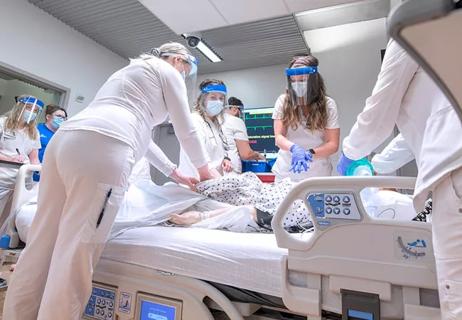Advertisement
Decision tree amplifies commitment

By Maureen Schaupp, MSN, APRN-CNP, CHFN, Associate Chief Nursing Officer, Advanced Practice Nursing, Nursing Quality and Practice
Advertisement
Cleveland Clinic is a non-profit academic medical center. Advertising on our site helps support our mission. We do not endorse non-Cleveland Clinic products or services. Policy
At Cleveland Clinic, caregivers are encouraged to follow a just culture process to help maintain and improve safe practices. The purpose is to provide caregivers an opportunity to learn from mistakes while improving systems to deliver highly reliable patient care.
Across the health system, nurse leaders play an important role in ensuring individuals and teams implement and use Cleveland Clinic’s just culture process. They empower caregivers to think critically, speak up and openly share their perspectives while also driving accountability.
Nurse leaders support Cleveland Clinic’s just culture in several ways, including:
Although Cleveland Clinic has followed a just culture process for several years, the health system recently introduced a new just culture decision tree to enhance its safety commitment.
In a just culture, the goal is for all who are involved in a safety event to learn and understand why an error occurred to ensure that it does not happen again. Cleveland Clinic’s just culture decision tree provides an intentional, objective way to look at an event and see if there is room for improvement. The new process is rooted in the organization’s leaders taking accountability for system issues and improving on them. It’s also about not deviating from Cleveland Clinic’s core values and ensuring that caregivers know their leaders support them when they raise their voices.
Cleveland Clinic’s just culture decision tree was adapted from the work of Professor James T. Reason of the University of Manchester and the National Health Service of the United Kingdom. It is used to determine acceptable or unacceptable behavior and is grounded on non-punitive responses to unintentional error and blame-free reporting, although those who act recklessly or take unjustifiable risks are subject to disciplinary action.
Advertisement
By standardizing the approach taken to safety events, the just culture decision tree supports conversations between managers and caregivers about whether the response to a safety event requires systems changes, specific individual support, or intervention to work safely. It also creates consistency and helps identify practice gaps.
Cleveland Clinic’s just culture decision tree includes six key questions or focus areas:
Deliberate Harm: Helps managers identify at the earliest stage possible the rare cases where harm was intended. Asks the manager to consider whether the individual’s actions and outcome were as intended.
Health Test: Helps to identify whether ill health or substance abuse caused or contributed to the patient safety incident.
Standards Test: Examines whether protocols and safe working practices are in place and were followed. Managers are alerted to situations that might appear to be a workable protocol initially may be problematic in practice or if there is a gap and a protocol needs to be developed where one did not exist previously.
Substitution Test: Assesses how a peer would have likely dealt with the situation. Highlights any deficiencies in training, experience or supervision that might have been a factor in the event and helps assess whether the individual was properly equipped to deal with the situation.
Advertisement
Risky Behavior Test: Helps determine if the actions taken would be considered risky under any circumstances. Considers whether the act is part of a pattern of poor decision-making or repetitive risk behaviors.
Mitigating Circumstances: These include exceptional, unforeseen and unpreventable events which may have played a role in the outcome being reviewed.
To better understand the decision tree process and ways to increase psychological safety, address system failures and support accountability, nurse leaders and others are required to complete a new 15-minute online training module, “A Fair and Just Culture at Cleveland Clinic.”
Leaders also participate in just culture refresher workshops and other available training activities. These trainings often include example scenarios in which leaders use the just culture tree to determine appropriate action. Scenarios are provided for a variety of caregiver groups, including pharmacy, facilities, engineering, nursing and more. An example of a nursing scenario is as follows:
A nurse arrives at the patient’s bed with two syringes in her pocket. One was prepared by her at the central nurse’s station and had no patient name or medication label. The second syringe was also missing a label, and the nurse didn’t know where it came from. She assumed she picked it up by mistake from the station. Knowing that she had just prepared a medication with 2 mL of the drug, and the second unknown syringe only had 1.5 mL, she decided to administer the 2mL syringe.
To complete the training exercise, nurse leaders go through the just culture decision tree process. In this scenario, upon arriving at the risky behavior test, leaders would likely determine a pattern of poor decision-making by the nurse.
When caregivers understand the just culture process, it helps leaders and their teams to speak up and promotes a safer space to learn. When this happens, caregivers feel supported and part of the solution and, ultimately, leads to a positive impact on the care that is provided to patients.
Supporting a culture of safety is a strategic priority for the Zielony Nursing Institute and the Cleveland Clinic organization. Having a strong commitment to safety by embedding a just culture process into every day practice ensures the most benefit for caregivers, patients, and patients’ families — and is an important part of nurse leaders’ jobs.
Advertisement
Advertisement

Nurses are well-positioned to appraise and integrate evidence into clinical practice to provide quality patient care

Leadership rounds educate nurses and foster teamwork

Veteran nurse shares his experience as a caregiver and community volunteer

Hospital earns nine exemplars from the Magnet Recognition Program®

Supporting newly graduated RNs before and after the pandemic

PULSES sets forth six critical steps

Creating a roadmap to get everyone on board

SHINE program is seeing results